What are the best doors to put in the rooms?
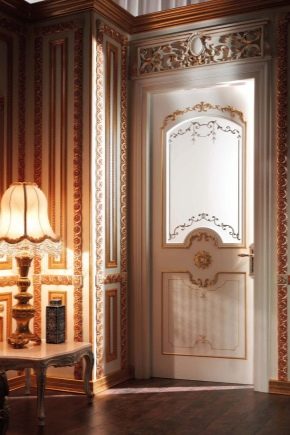
Interior doors are not an overkill, but a way to isolate functional areas in a room from each other. Their presence is fundamentally important if there are children in the house, one of the family members has an office, separate bedrooms, and they like to cook a variety of fragrant dishes in the kitchen.
Which doors are best placed in the rooms depends on the purpose of these rooms and the requirements imposed on them for tightness, insulating and aesthetic properties of door panels.

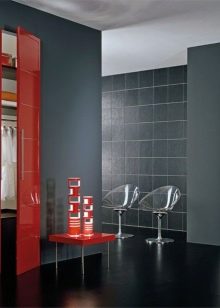
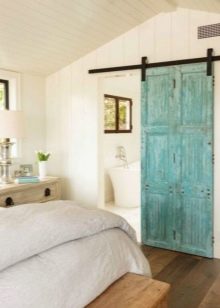
All types of structures and models
It would seem that when choosing an interior door, no difficulties can arise, except that family members may not agree on tastes, and one will insist on a white door, and the other on a brown one. But the nuances of the choice are not limited to this. There are a large number of models, the design features of which play a decisive role. The convenience of its operation, durability and preservation of a presentable appearance depend on how the design meets the tasks.
A door that is installed in a pantry is not capable of ensuring the security of securities in a study, and a door to a bedroom is very different from a door for a bathroom.

The functions of interior doors are varied and have different functionality:
- They visually separate rooms in a room, be it an apartment, a private house or an office;
- They demarcate specific functional areas: bedroom, kitchen, gym, bathroom, toilet and other types of premises for a specific purpose;
- Provide various kinds of room insulation: keep warm, do not allow extraneous sounds to penetrate, do not allow condensation to form in rooms with high humidity;
- They guarantee the safety of valuable documents and things inside the premises;
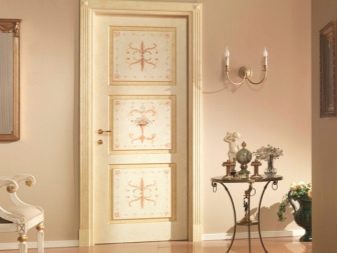
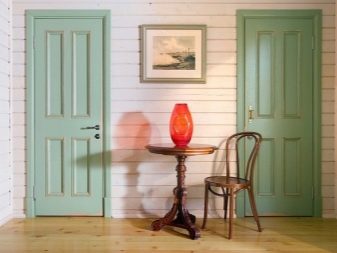
- Helps maintain a cozy privacy in intimate areas;
- Provide safety for young children by blocking access to traumatic items in pantries or in the kitchen.
In this regard, interior doors differ among themselves according to several criteria: type of construction, method of opening, purpose, materials.
Construction type is a generalized concept. It includes the overall parameters of the product, and the shape, and features of the door leaf.
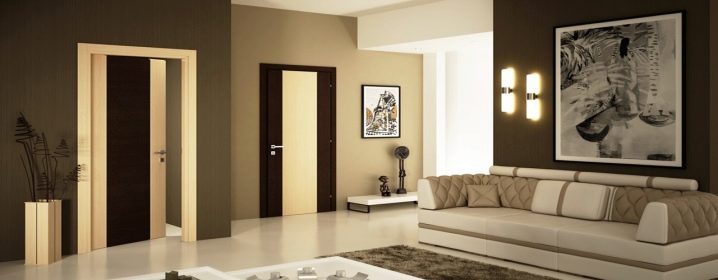
By size
In terms of size, interior doors are:
- Single-leaf (single-leaf). They are suitable for typical apartments with standard doorways.
- One and a half. This intermediate size is a frequent occurrence in the houses of the so-called "old fund" and "stalinkas", where doorways are several tens of centimeters larger than the standard width and may differ in greater height. Door leaves with a width of up to 110 cm belong to one and a half, and everything that is larger is double doors.
- Bivalve (bipartite). An indispensable option for installation in old buildings - the past or the century before last, when wide doorways prevailed between all types of rooms in the room.It is convenient to use such doors to isolate a bedroom or living room or premises in country houses and cottages, where an abundance of free space and large areas of rooms require appropriate dimensions in the interior.
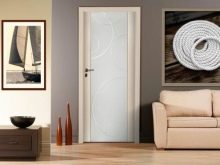
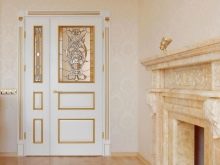
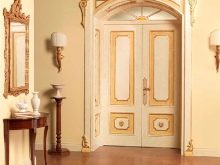
By the shape of the canvas
By shape, door leaves are divided into:
- Classic. Such doors have the usual rectangular shape. The width in relation to the height is 2-4 times less, it depends on how narrow or wide the doors will be. They are installed in those rooms where the size of the doorway is designed for a single-floor door;
- Arched. This design is distinguished by a complicated line of the upper edge, which forms an arch. Necessary for doorways of a similar shape or maintaining a certain style in the interior;
- Swinging (stable, saloon). They cannot be called full-fledged doors, but nevertheless, this original product takes place in some non-trivial interiors. In appearance, they resemble double doors at the entrance to the "cowboy" saloon. As a rule, they are made to order according to individual sizes and designs.
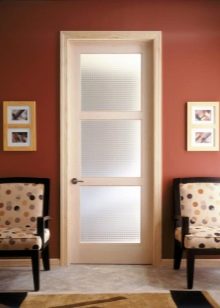
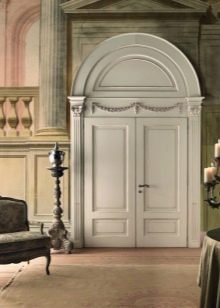
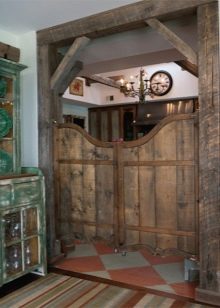
By the construction of the canvas
Deaf and combined (open) doors are distinguished depending on whether the door leaf is made in one piece or segmented.
Deaf
The deaf are divided into panel and paneled.
Shield - This is the most common option for door designs. As the name implies, these doors have flat front and back sides, without relief, decor and frills. They are distinguished by their reliability and high insulating properties due to the peculiarities of their structure.
The structure consists of the following elements:
- Frame. It is assembled from beams and stiffeners that increase the strength of the product;
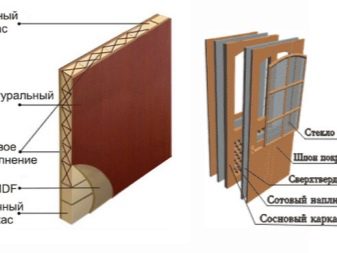

- Filler. It fills the space between the stiffeners for better thermal insulation and sound insulation. For this purpose, edged boards, mineral wool, polyurethane foam, polystyrene, expanded polystyrene, polyurethane foam are used.
- Overlays. They are embossed and smooth. With the help of embossed patterns on the door, a pattern is created, smooth ones differ only in color or the presence of a wood texture.
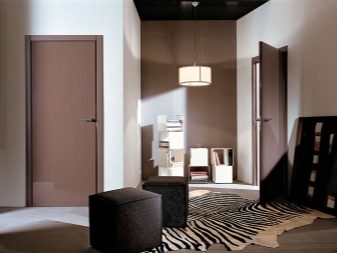
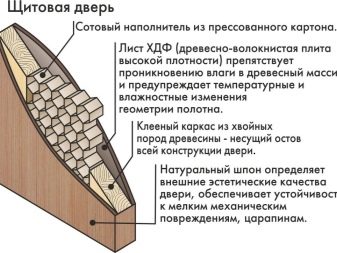
Paneled doors Is a prefabricated structure based on a wooden frame with grooves. Decorative embossed elements made of MDF, chipboard, pressed paper are inserted into the grooves. You can assemble such a "constructor" with any pattern and texture that will match the interior design.
Door panels made of panels have practically no flaws if the door is made by a bona fide manufacturer.
But there are a lot of advantages:
- Aesthetic appearance;
- The ability to create original decor. A special design chic is paneled doors with patina, that is, with the decoration of the figured elements and the relief of the door in a different color or material. One luxurious example is the white door with gold trim;
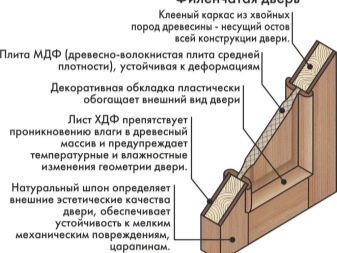
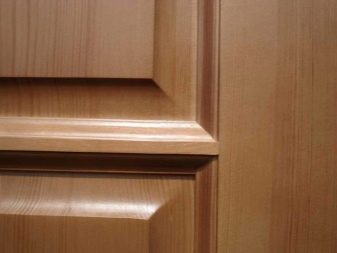
- Less weight of the canvas, since the inserts weigh less than solid wood used in panel structures;
- Long service life;
- The ability to replace damaged fragments;
- Cost reduction due to the use of budget materials.
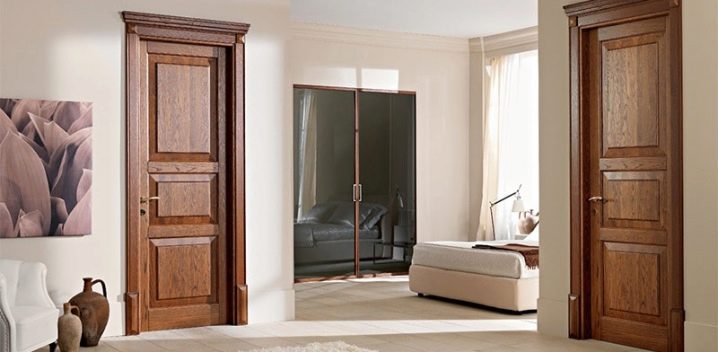
Combined
The combined ones include tsarovy and "open" doors.
- Tsargovye doors often called paneled varieties, since the principle of their assembly is almost identical. However, side doors have a more laconic and elegant design. The "core" of the door is filled with special plates - drawers, of different widths and from different materials. When alternating wood with other materials, for example, glass, an interesting and simple decor is obtained.
- Open doors are a combination of a wooden, plastic or metal base and a glass or mirror insert, which takes up a significant part of the canvas. As a rule, frosted, opaque glass is used. It can have dusting, sandblasting, relief, or even be stained glass.
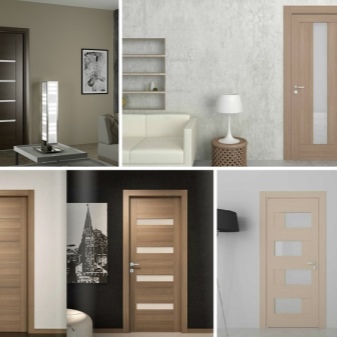

For absolute isolation of the room, "spy glass" is used - transparent on one side and mirrored on the other.
By opening method
By the way of opening the doors are divided into:
- Swing. This is the standard option used in most residential and administrative areas. They differ in the number of sashes (one or two, while double doors do not necessarily have sashes of the same width) and in the opening side (right-handed, right-handed, left-handed, left-handed). Swing doors are considered universal and are not suitable only in cases where there is not enough space to open the door wide open. They are similar to swing doors, but they are distinguished by one feature - they open both towards themselves and from themselves.
Outwardly, this design resembles the doors at the entrance to the metro.
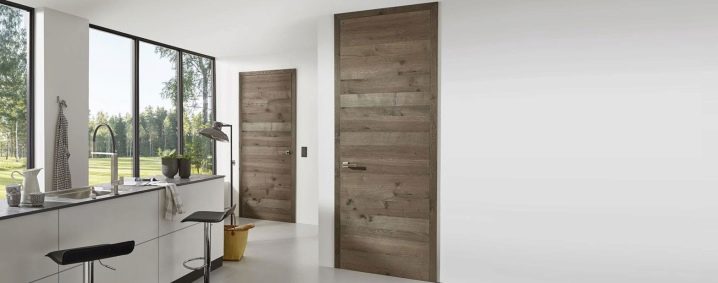
- Sliding. They are divided into several varieties:
- Retractable or hinged. A door leaf of this type "walks" by a special mechanism - a monorail on wheels. Rolls back to the left or right side;
- Compartments or suspended. The mechanism works on the principle of sliding wardrobe doors and can consist of 2,3,4 or 5 canvases. Such a door can easily replace the internal partitions in the room, dividing the space into zones. Due to the fact that all the doors are on rollers, they can be moved with one hand movement, and if the rollers are gel, then this process will be absolutely noiseless;

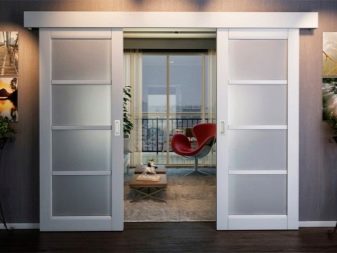
- Cassette. The best option for rooms where space saving is in the first place. Cassette doors do not take up space at all - when opening, the door leaf enters a groove in the wall;
- Telescopic or cascading. These are numerous door leaves in the form of partitions, moving along guides on automatic control. By the principle of operation, they are similar to compartment ones, but the design is more complex and equipped with a remote control. They can serve as interior doors and partitions indoors.
- Radial. These transformer room doors can only be installed in spacious rooms, since their movement is carried out in a circle and requires a lot of free space. The manufacturing process of radius doors is expensive and laborious, so such products are elite.
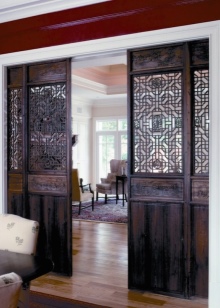
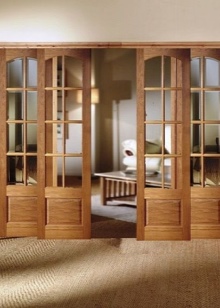
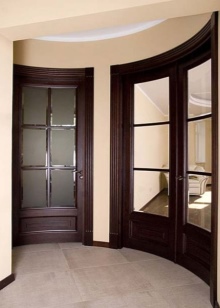
- Foldable. Along with cassette doors, these doors are designed for small spaces. Their unique design allows you to optimize space due to the fact that when folded, the door takes up almost no space. These include accordion doors and folded doors. They consist of wide lamellas, connected by hinges, which, when opened, fold on top of each other like accordion furs, for which the structure received this name.
Their only drawback is that, when assembled, they occupy part of the doorway.
- Swivel. The roto door is a unique mechanism that allows you to open the door both to the right and to the left, from the inside and outside. They have the same drawback as the accordion door - they "eat up" the width of the doorway.
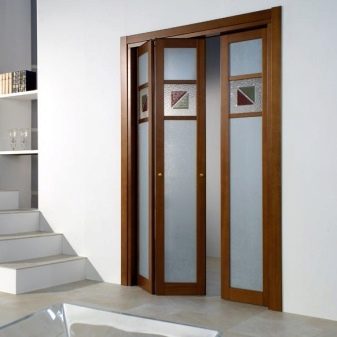
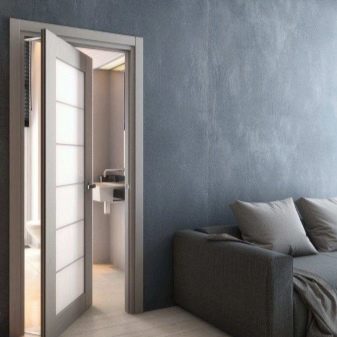
By appointment
According to the purpose, the interior doors in the premises are divided into doors for residential premises, for public and highly specialized ones.
In a residential building interior doors can be located on the border of different zones:
- Living rooms;
- Corridors;
- In the bedroom;
- Cabinet;
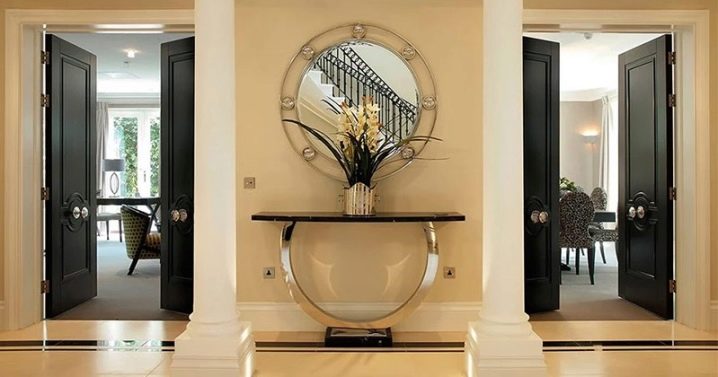
- Kitchen;
- For the bathroom;
- Attic or attic.
- In some cases, during redevelopment, balcony doors become interior doors.
Doors in public, administrative and municipal premises must correspond to the status of the institution and isolate extraneous noise, the rest depends on the design of the premises and the financial condition of the organization.
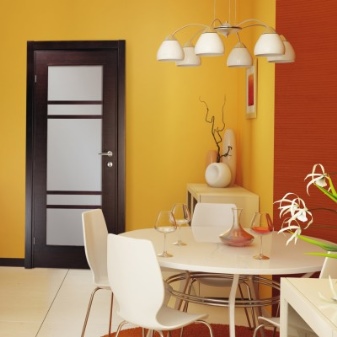

Specialized doors are:
- Demarcation;
- With increased sound insulation;
- With increased thermal insulation;
- Fireproof;

- Waterproof;
- Sealed;
- Concealed;
- Emergency;
- False;
- Protective (shockproof, anti-burglar, anti-channel, bulletproof, energy-saving, sealed).

Varieties of materials
The purpose and location of the doors affect the choice of materials from which the product is made. So, a bedroom needs doors with good insulating characteristics so that extraneous noise does not interfere with sleep, the kitchen needs doors with a washable coating, and the doors in the bathroom must be resistant to moisture.
Modern manufacturers use different materials that are worthy of detailed consideration.

- The tree and its derivatives:
- From an array. These are reliable, often blind structures, distinguished by aesthetics of appearance and environmental safety. Such doors can be solid or hollow inside (Masonite). Karelian birch, ash, larch, pine, oak beams are used for manufacturing. Maple, hazel and alder are less commonly used;
- Made of plywood. Such a sheet has almost the same properties as solid wood doors, but it is lighter in weight and lower in cost. The small thickness of plywood makes this material convenient for the manufacture of non-standard designs: "accordions", "books" and corrugated doors;
- Made of MDF, fiberboard, chipboard and chipboard. This is a budget alternative to the array, but it also has fewer advantages. Doors made of these materials hold heat worse, pass sounds without a high-quality interlayer, are less wear-resistant, do not provide such wide design possibilities;
- From the lining.
- Rack and pinion.
- Veneered.
- Laminated.
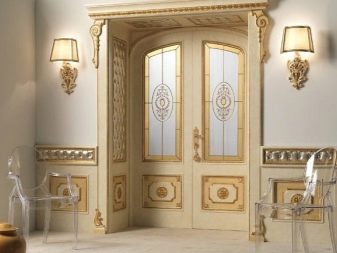
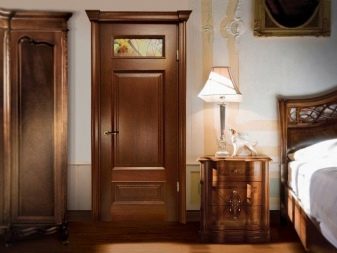
- Metal. It is used in cases where additional protection is needed inside the premises for valuables, important papers and documents. Steel doors are considered the most reliable. If bank-grade security is not needed, an aluminum or iron structure is sufficient. And so that such a door does not argue with the interior in the house, you can use models with PVC coating or natural wood veneer;
- Plastic. Ideal for rooms that require frequent wet cleaning, such as a kitchen, or high humidity (bathroom). Also, plastic and fiberglass doors are able to provide high-quality sealing and good noise insulation, but fiberglass doors look more aesthetically pleasing and are easier to decorate;
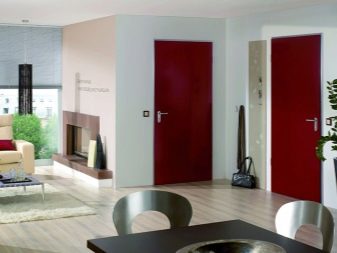
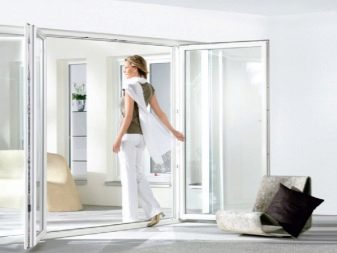
- Glass... Pure glass, even if it is made using the triplex technology (not breakable), can hardly be found in the interior. As glass, transparent, glossy or matte, colorless and colored, plexiglass, acrylic and plexiglass are used, which are essentially a kind of plastic. These materials are much lighter, safer, less prone to damage and easier to clean. They look great in the shower and bath, they are suitable for the kitchen;
- Combined models. These are doors with an interesting design, which is obtained through a combination of different materials: metal and finishes from stone, wood and glass, glass and plastic.
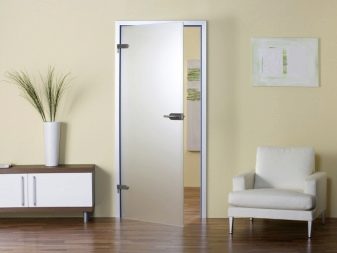
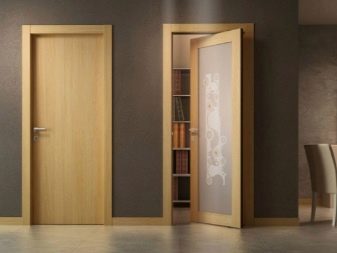
Advantages and disadvantages
The presence of interior doors is a necessity dictated by living conditions. However, it is important to understand that any model in itself and in relation to the location in the room has its pros and cons.

From an array
Advantages:
- Material of natural origin, which not only does not cause allergies and does not emit toxins, but in some cases disinfects the room (bamboo, birch, coniferous wood);
- Exceptionally high quality products for any type of wood;
- The tree retains a pleasant aroma for a long time;
- Wood products will always be classified as noble, expensive and beautiful in the interior;
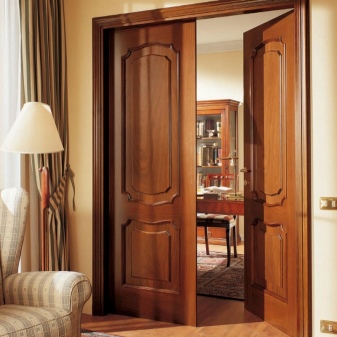

- High indicators of wear resistance and resistance to mechanical damage;
- Provide excellent thermal insulation and sound insulation;
- Ample opportunities for design: wood is subject to processing, painting, impregnation with various compounds that affect the structure and color;
- The ability to produce designer canvases with variable details that can be changed with the change of interior;

- Various finishes available;
- With a suitable coating and impregnation that protects the wood from mold and mildew, it can be installed in any room - from the bedroom to the kitchen.
There are few disadvantages of wooden structures. Among them - a large weight of the door leaf, if it is not hollow, the property of wood to shrink and "expand" from an increase and decrease in the level of humidity, a high price. Products made from valuable wood species are especially expensive.
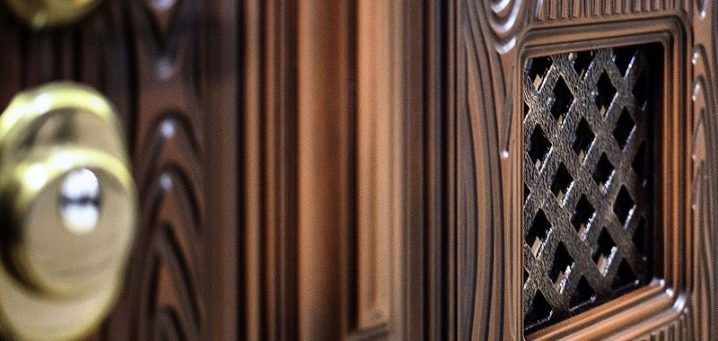
Plywood
Advantages:
- Low dead weight;
- The method of making plywood (5-7 wood plates glued together using resin) allows you to keep the wood pattern on the surface;
- Strength;
- Moisture resistance:
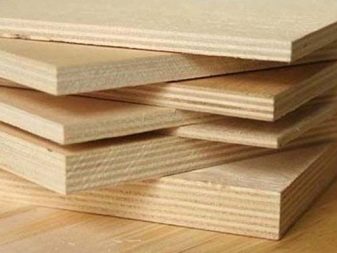
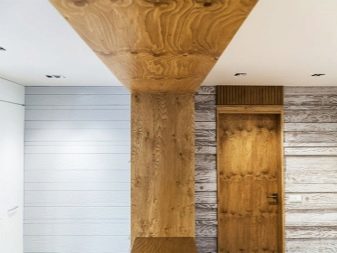
- Good insulating qualities;
- Environmental friendliness;
- The material does not shrink with changes in humidity and temperatures, which is very important when changing seasons.
Disadvantages:
- At constant humidity "swells";
- Hollow structures are not capable of providing maximum comfort and protection.
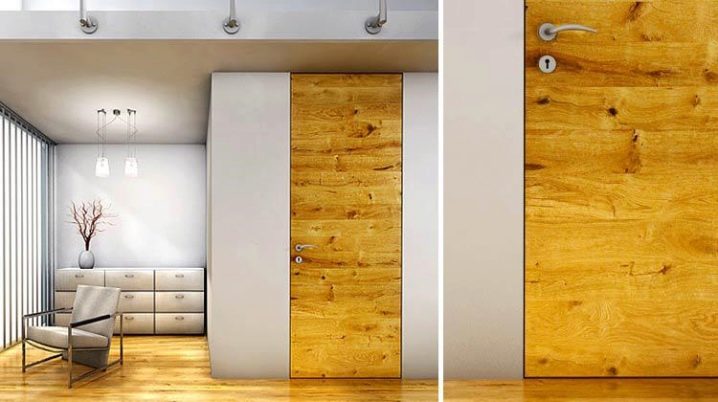
Made of MDF
Plywood and MDF are often confused, but it is important to understand that these are two different materials, and the fundamental differences between them stem from the manufacturing method. If plywood is a multilayer product made of wood plates and resins, then MDF is a derivative of fine shavings (sawdust) and adhesives.
Compact, simple and lightweight door leaves are made of MDF. Wood fibers are distinguished by good adhesion, therefore, the product is characterized by constant size with changes in humidity and temperature.
The door surface is smooth, even and uniform, which makes it easy to handle.
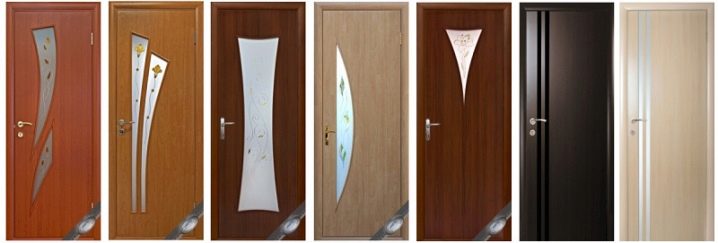
The main advantage of wood chip doors is their attractive price. Also, lightweight structures make it possible to install them on any type of walls, and the installation can be done independently. The right finish, such as veneer, can help make doors that look expensive and expensive. However, the performance characteristics are in many ways inferior to wood or plastic.
Doors made of MDF are afraid of water, as they can swell and begin to crumble, they are easier to break, complex decor is not available to them, and gluing compounds are not always environmentally friendly.
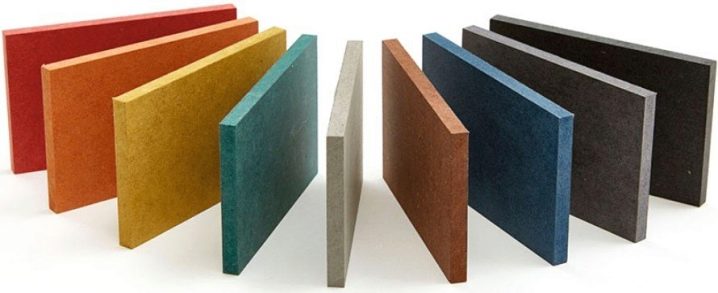
Fiberboard
Products made of fiberboard are close in quality to plywood and MDF. Unlike other materials made by pressing wood dust and shavings with the addition of adhesives, fiberboard is obtained by pressing steamed shavings, therefore, fibreboards are less hydrophobic. But this technology does not allow them to be made thick, which greatly reduces the performance of the doors. They are distinguished by their high density and hardness, but due to their small thickness, the range of their application is very narrow.

From chipboard and chipboard
This is the most common material for economy class products.
At a low cost, it has all the characteristics necessary for practical raw materials:
- Strength and density;
- Layering;
- Lack of internal voids, knots and irregularities;
- Availability of several varieties, of which even the best has a low cost;
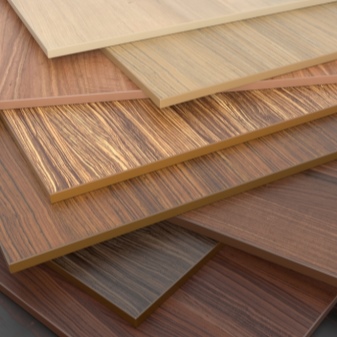

- In the production of doors, plates of the E1 emission class are used (the minimum content of formaldehyde resins per 100 g of weight), which is absolutely not harmful to the health of adults and children;
- It lends itself well to various types of processing. You can safely saw, plan, mill, drill, glue and paint;
- Biostable;
- Does not shrink from moisture and high temperatures;
- They have high performance on the scale of thermal insulation and sound insulation.
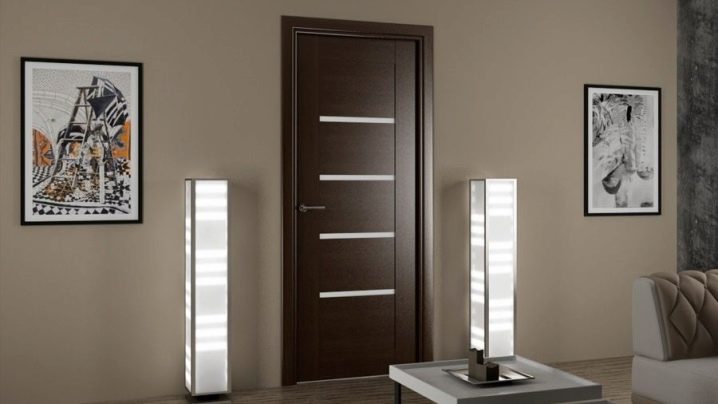
Disadvantages:
- The edges of the product can crumble during processing and in the places where screws or fixators are screwed in;
- Low-emission products are harmful to health, and manufacturers do not always label products. It is not recommended to purchase such a product;
- Particleboard exfoliates and crumbles from high humidity.

From the lining
In this case, we are talking more about finishing the door, and not about making it from lining, but as an outer layer, it is she who is responsible for the durability and appearance of interior doors.
The list of lining advantages consists of all the items that are inherent in solid wood products.
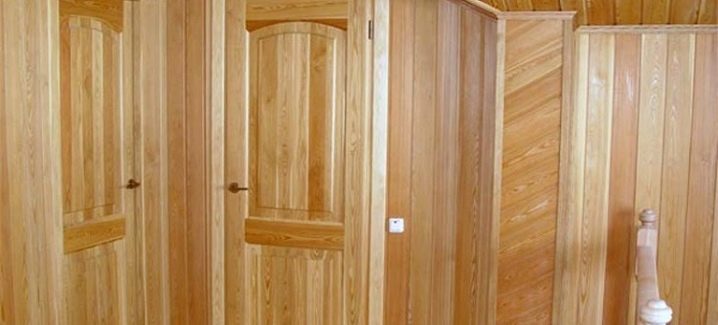
The characteristic features depend on the type of wood: pine lends itself well to various types of processing, linden retains a beautiful appearance in conditions of constant humidity, larch is the most wear-resistant, oak allows it to be painted in the colors of precious wood species. At the same time, a panel sheathed with clapboard has less weight than a solid one made of wood.
The lining has its drawbacks: in the absence of processing with special compounds, it is prone to rotting, premium products are of high cost, the surface for finishing requires preliminary preparation (grinding, priming, processing).
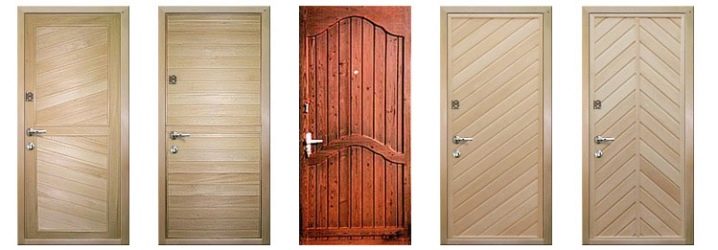
Made of metal
Advantages:
- Reliable in terms of burglary resistance. Even ordinary metal doors have a third class of burglary protection, and products reinforced with crossbars and platbands do belong to bank protection;
- In the manufacture of steel doors, mineral wool is used as a filler. This material has unique characteristics, so doors with such a filling are warm, fireproof, soundproof and non-toxic;
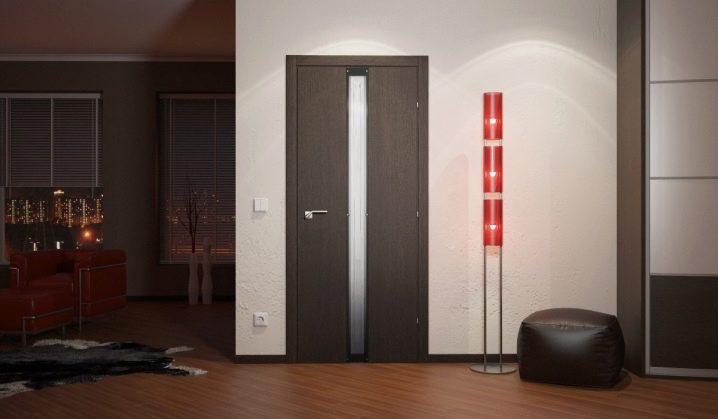
- Any kind of finish is available, be it veneer, lining or stone;
- Longest service life;
- Vandal-proof, damage-resistant, shock-resistant.

Disadvantages:
- In many interiors, such a door looks cumbersome;
- The weight of the door leaf is from 100 to 250 kg;
- By the type of opening, they can only be swing;
- A good steel door will cost a lot.
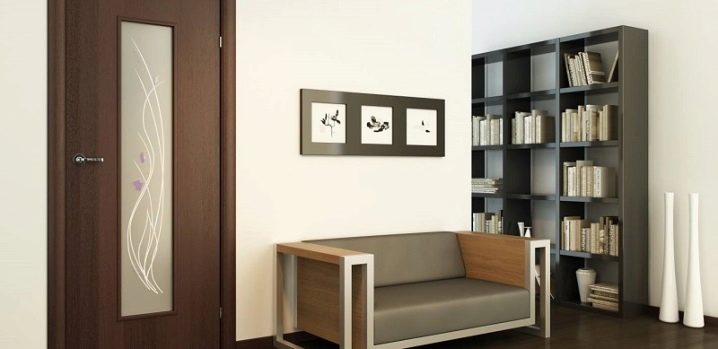
Made of plastic
Advantages:
- Functional. The range of their application is the widest, since they perfectly tolerate both humidity and heat, and have high burglar resistance. Such doors will serve for a long time in the kitchen, bathroom, office and even on the balcony;
- The basis of the doors is a lightweight and corrosion-resistant metal-plastic or aluminum frame;
- Nice appearance. All types of finishes are available for plastic doors, so do not be afraid that they will look like doors at the entrance to a supermarket. Even standard models are distinguished by an elegant and simple design, and the manufacturer will make an interior decoration in the desired style on an individual order;
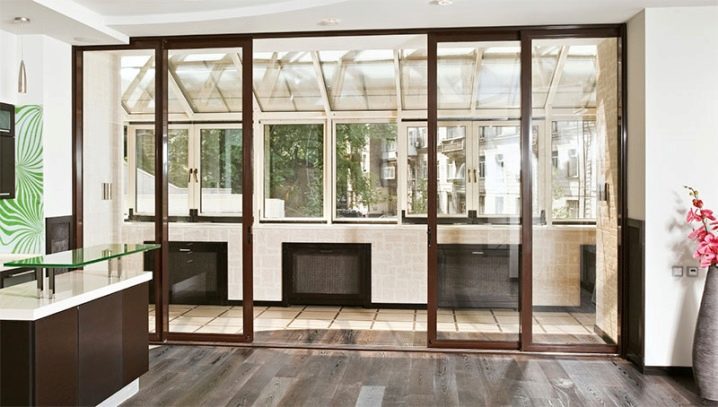
- Easy to clean, not afraid of moisture, therefore ideal for kitchens, bathrooms and utility rooms;
- Quiet. Many plastic doors are equipped with a smart closing mechanism that allows them to be closed smoothly, without a pop;
- Plastic doors can be of any complexity and they have access to different opening mechanisms - from sliding to telescopic;
- Insulated interlayer is not required. Air chambers are provided in PVC structures, which are responsible for sound insulation and heat preservation in the room;
- Sealed;
- Durable.
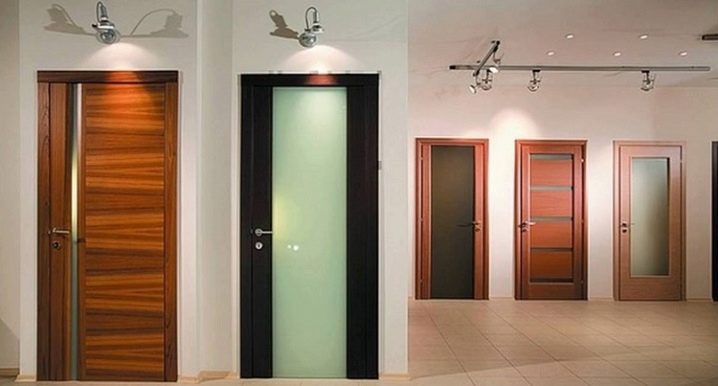
Disadvantages:
- The plastic is soft in structure and easily damaged. Scratches and dents from impacts may remain on it;
- The protective decorative coating does not prevent the plastic from becoming cloudy over time, turning yellow and becoming inconspicuous;
- The settling dust and dirt eats into the material over the years, and it cannot be washed off without aggressive chemicals;
- Flammable and releases toxins.
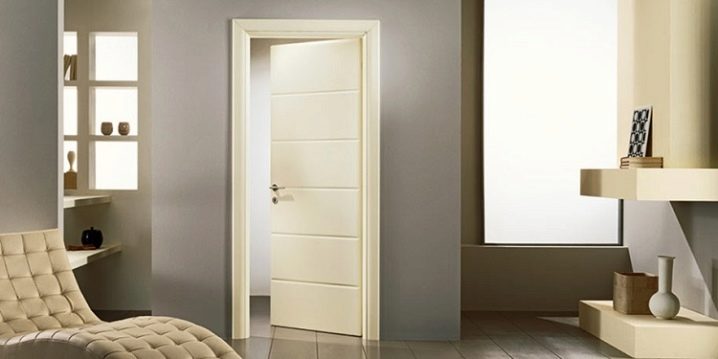
From glass
Advantages:
- Durable. Modern production technologies make it possible to use different types of glass: tempered, acrylic, triplexes. These materials are difficult to break even intentionally, and the protective film, if damaged, will not let the debris fly around;
- The doors of almost all opening mechanisms are made of glass;
- This is an original design solution that not only decorates the room, but also helps to visually enlarge it;
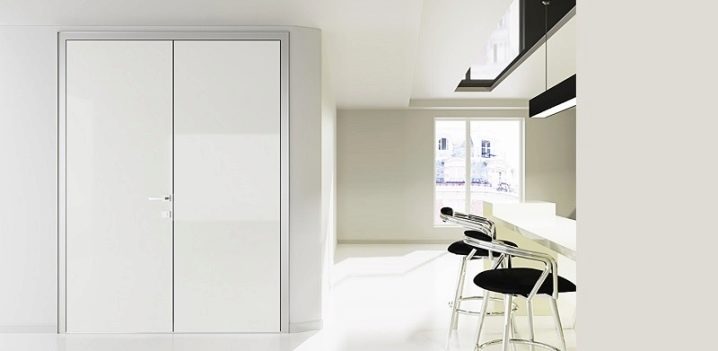
- Glass does not have to be transparent, other options are available: frosted, tinted, patterned, mirrored, colored, stained glass;
- Provide excellent sound insulation;
- They are not afraid of water, therefore they are suitable for all types of premises;
- Fireproof;
- Long lasting.
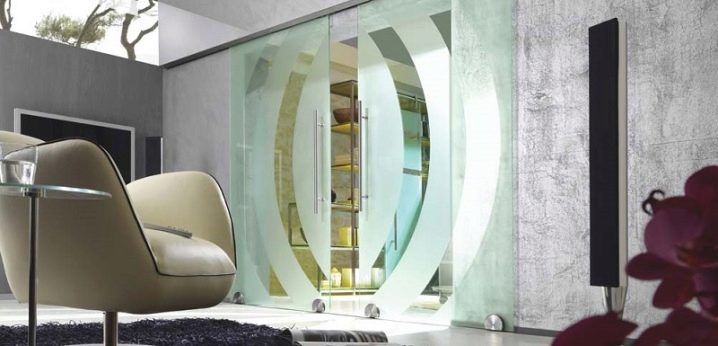
Disadvantages:
- Not suitable for rooms with a small area;
- High price;
- For glass doors, ordinary fittings are not suitable, and specialized ones are many times more expensive;
- Complex structures are heavy;
- Installation requires the participation of professionals;
- Any dirt is visible on the glass surface, so they have to be washed very often.

How to choose the right one?
Choosing good interior doors is a responsible event. Their installation and dismantling takes time and money, so it is important to make a choice in favor of a high-quality, reliable and easy-to-use product from the first time.
And in order to minimize possible errors, it is worth adopting advice and guidance from professionals in the field of renovation and design:
- The first thing that needs to be done by everyone who is thinking about which interior doors are best to put in an apartment or a private house is right evaluate the functionality of the premisesat the border of which a door is required. In places with high humidity, it is worth refraining from wooden products, in rooms with high traffic, doors with high-quality fittings should be installed, in children's rooms only doors made of natural materials or those corresponding to GOST can be installed.

- The second important step is correct measurement... It is necessary to measure at least two, and ideally three points along the width and height of the doorway. It is also important to measure the depth (wall thickness) in order to understand whether extensions are needed and what width.
- The door leaf must be purchased with a suitable box. Replacing the box and jambs is very important, as it helps to avoid distortions and problems during operation in the future. In this case, the box (frame) must be wider than the thickness of the door.
- Door thickness Is an important indicator that characterizes its insulating qualities.
The thicker the door, the more likely it will perform its thermal and sound insulation functions perfectly.
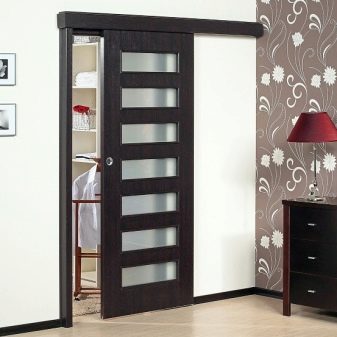
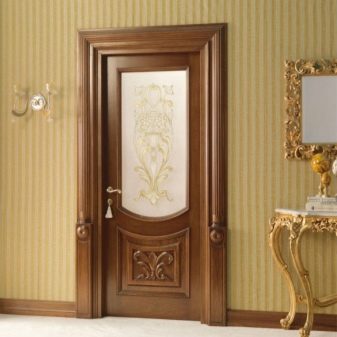
- Opening mechanism plays an important role. A large space allows you to install doors of any type, but narrow rooms, for example, the corridors of "Khrushchev", require compact solutions - cassette, compartment or folding canvases. Internal steel doors, like external ones, are most effective when the swing mechanism opens "towards itself", since it is more difficult to knock them out and in any way damage them.
- Design features of doors Is not only a matter of aesthetics. In some cases, non-standard solutions are simply needed. So, for storerooms and utility rooms, doors with a ventilation grill are recommended so that things do not acquire a musty smell, and in houses of the old foundation with a ceiling height of 3-4 meters, doors with a transom are needed (a fixed part of the structure that is built on top of the door, visually making it higher ) to balance the proportions.
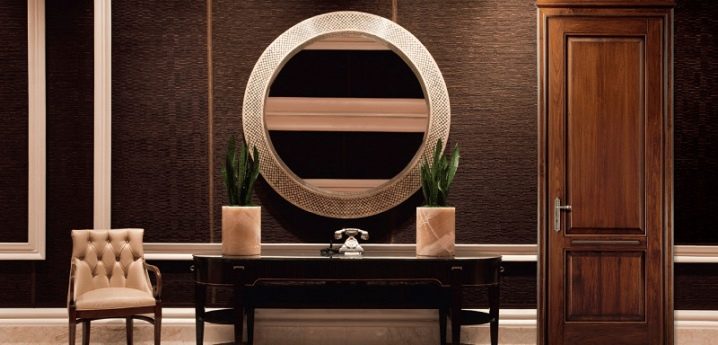
- It is also important to pay attention to materials from which the door is made, the presence and quality of the filler, the weight of the structure, the type of finish, the insulating properties (does it retain heat, tightness, does it block noise).
- Deserves special attention fittingsespecially when choosing glass doors. It must be of high quality, correctly installed and, if necessary, easily replaceable, since its service life is only 5-10 years, while the door leaf itself can serve more than 30.
- Study of components and technical documentation for compliance with GOST, safety and guarantees will not take much time, but will save you from many problems in the future.
- Design doors must match the prevailing style in the interior.

How to choose the size?
When choosing the size of interior doors, it is important to make accurate measurements, taking into account possible changes before installing them (laying tiles, porcelain stoneware, laminate and other flooring that will raise the floor level by 1 centimeters or more; expanding the doorway).
The standard door leaf height is 200 cm. This corresponds to doorways in typical buildings, taking into account the installation of the frame and platbands. Measurements are made at two points along the slopes and one in the center. If the house has high ceilings and as a result of measurements it turns out that the height of the opening is more than 250 cm, it is necessary to install a transom. At a height of more than 210 cm, it will be necessary to install wide platbands, and in the opening below 203 cm it will be problematic to "squeeze" standard doors with a frame. You will need to cut the door leaf or make a small drink in the opening.
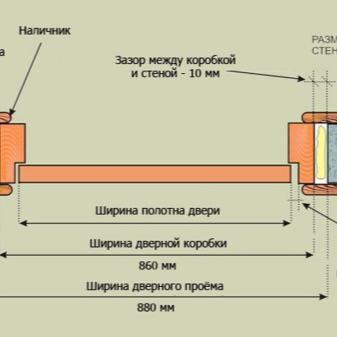

The width of the interior doors depends on the type of room. It can vary between 50-90 cm, with the narrowest doors being installed in separate bathrooms and storage rooms, and the widest ones in bedrooms and living rooms.
Classic solutions imply the choice of a door leaf 7-14 cm narrower than the opening. That is, with a width of 67-73 cm, a door leaf of 60 cm is required, with 87 - 80 and further.
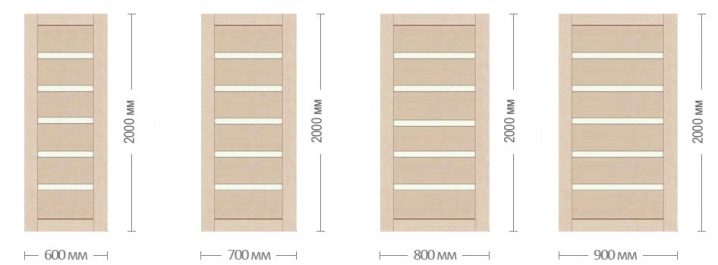
By width, the doors are divided into single-floor (from 50 to 80 centimeters), one-and-a-half (80-120 cm), double or double-leaf (from 120 cm, while the doors can be the same in width or different in size).
The third required parameter is the wall thickness. If it is more than 7 centimeters, the door must be completed with extras. Dobors are strips that frame the doorway if the wall thickness is greater than the thickness of the box.
Addons are made from the same material as the box and canvas.
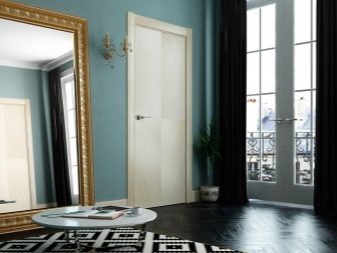
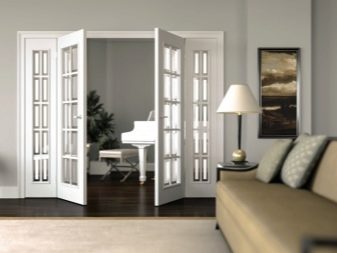
What is included?
The accompanying documents for the interior door must indicate the complete set of the product. Some of the elements necessary for assembly may not be included in the kit, and you will have to buy them yourself.
The complete set depends on the type of doors, design features and opening mechanism.
A set of standard swing doors, single and double doors, fixed or open, includes:
- Door frame;
- Shield (canvas)
- Platbands;
- Fittings: door hinges and handles, latch bolts are a plus for double doors. There are two types of handles - knobs and rotary. Nobs are round, cone-shaped, square, concave double handles, which are of 4 types: stationary, rotary with a latch, rotary with a lock, and rotary with a lock. Push-down - narrow, L-shaped handles, opened by pushing down. Also available with latch and lock.
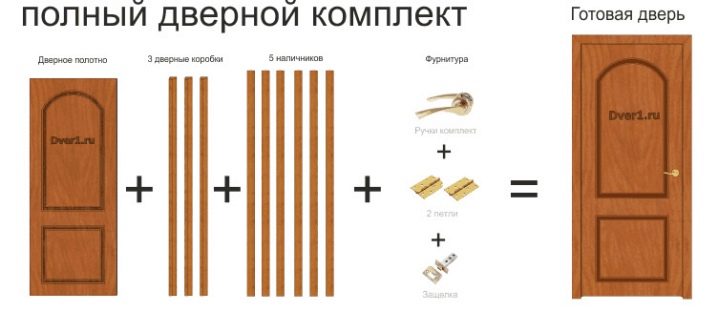
Additional elements for swing doors:
- Dobory;
- Transom;
- Thresholds.
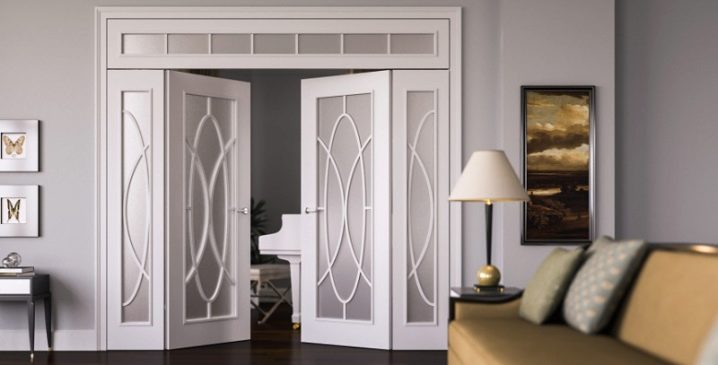
Accessories for sliding doors, including sliding doors, radius, telescopic structures:
- Door shields (2 or more);
- Guides (with top or bottom rail);
- Sliding system (carriages): rollers, thrust mechanisms, bearings, mounting plates;
- Metal cassette (necessary in order to hide the canvases in the wall when the device is assembled);
- Fittings.
- In some cases, anti-thresholds.

The folding door kit includes:
- Door frame;
- Platbands and extensions, if necessary;
- Long side rails;
- Short guide (top or bottom);
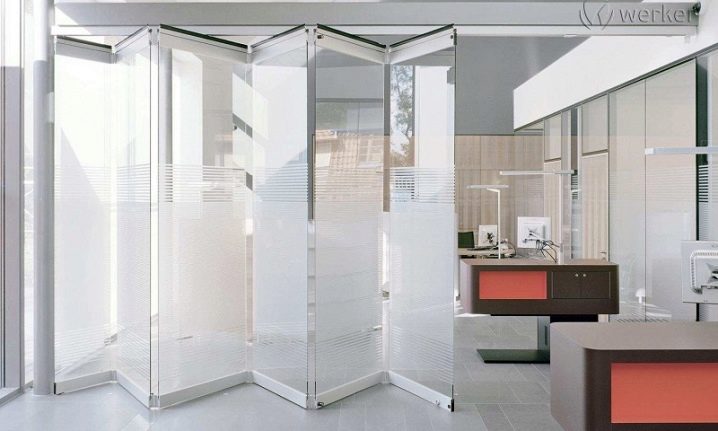
- From two slats (shields that make up an accordion door or a book);
- Fasteners (clips, screws, gaskets);
- Roller mechanism:
- Stoppers (stops).
- Door handles, latches, hinges.

The assembly of roto (swing) doors is carried out from the following elements:
- Door frame;
- Shield;
- Unique swing-sliding mechanism: guide with groove, swivel joint with roller, upper and lower arms, upper bar with carriage, lower bar;
- Platbands;
- Fittings;
- "Smart" anti-threshold.

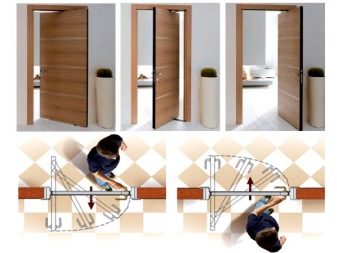
Color selection
There are no strict rules for choosing the color of interior doors.However, they occupy a fairly large area in the interior, and it is difficult to make them invisible, so an unsuccessfully chosen color can become an unnecessary element in the stylistic composition of the room.
To prevent this from happening, experienced designers have developed a number of effective recommendations for choosing the color of interior doors:
- A palette of natural shades. For many interiors, there is nothing better than naturalness. The color of natural wood, as it is, even if it is just a veneer finish, meets the requirements of classic interiors, some ethnic and modern trends, eco-styles close to nature. You can support the desire of modern interiors for laconicism and functionality with the help of deaf structures of different shades (beige, ivory, walnut, graphite, cappuccino), and the craving for luxury in a historical style will be satisfied with aged canvases in shades of expensive wood species (cherry, mahogany, wenge, mocha, teak) and with complex decor (gilded patina, stained glass, laser cut).
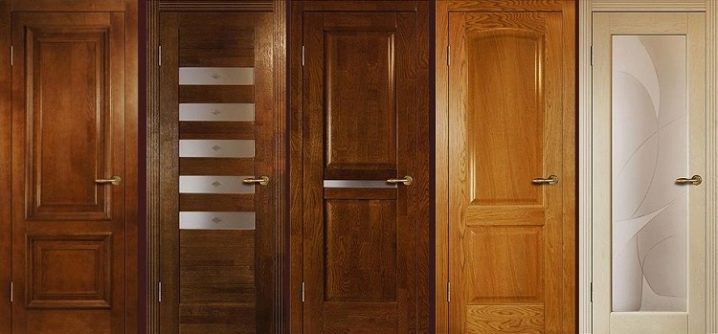
- Warm colors in a warm interior. In order not to miss and not break the harmony in a cozy interior of warm and eye-pleasing shades, it is worth stopping the choice of the color of the interior door on the same warm spectrum. It can be red, orange and yellow of different saturation, ocher, baked milk, mustard pear, nut, brown, some green colors. It goes well with the warm color "gold" fittings.
- Here you can also note pastel colors. (peach, powdery, pistachio and others). At the same color temperature as red or yellow, they have less saturation, but they also harmoniously integrate into the overall interior composition.
- Cold colors for cold interiors. Such shades are characteristic of Gothic, Romanesque, Scandinavian interiors and contemporary minimalism, loft, techno. Blue, gray, cold white, dark colors, elements made of plexiglass, acrylic, plexiglass, chrome and mirror surfaces, silver fittings work perfectly here.
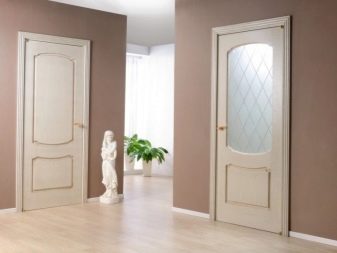

- Using contrasting shades. White is perfectly visible on black, and black sets off whiteness. This rule can be used by choosing dark doors with a light floor (cherry wood and light gray porcelain stoneware, black teak and white laminate), and vice versa (dark walnut parquet and white doors).
- Universal color. Using the basic palette, it is important to correctly place the color spots in the room, but due to the successful combination of these colors, the task is greatly simplified. The base includes: white, gray, light lemon, terracotta, cream, sand, beige, coffee with milk, pearl, pure wood color, lilac, light pink, mint, pale blue, marsh green.
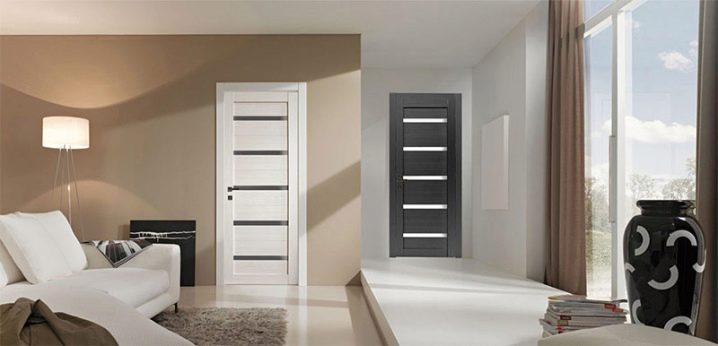
- Doors in the color of the skirting boards. A common European method is the selection of materials of the same color. It also has the opposite technique - the use of contrasting colors.
- The color of the walls. This technique works great in rooms where the color of the walls is the same. The doors become less striking, and the overall appearance of the room is more harmonious.
-
To match the color of the floor covering. The floor covering occupies a significant part of the room, and it is not so difficult to select a color spot of a similar tone on the wall. The combination of the same colors, but different textures, looks especially interesting.
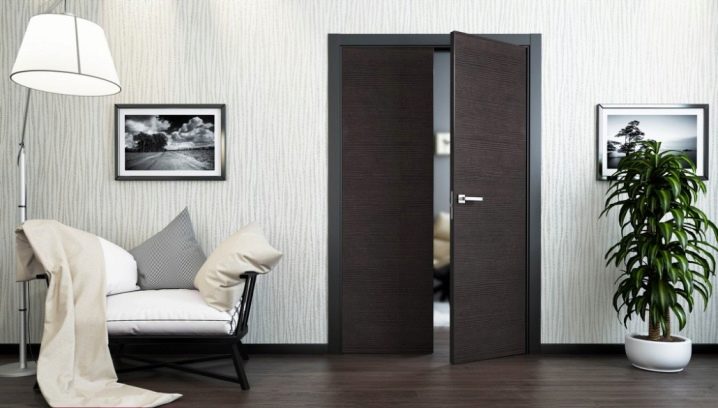
- For furniture. A furniture group can also become a color fulcrum, the main thing is to correctly determine the prevailing shade, if the furniture is not monochromatic or assembled from different objects in the same style.
- Under the window frames. This is the most basic but effective method. The only condition is that the window frames must be visible through the curtains.
Otherwise, the color of the doors will have to be matched to blinds or curtains, and changing the window decor will be problematic.
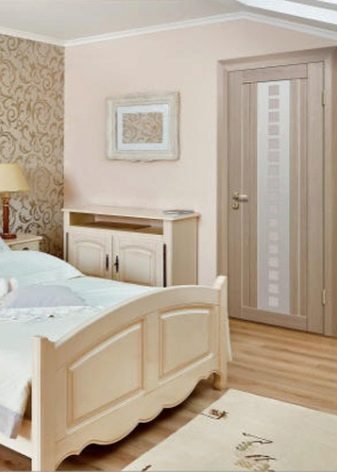
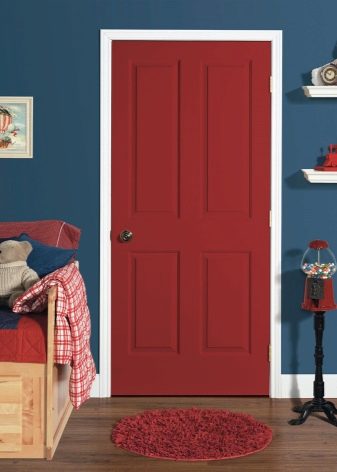
Famous manufacturers and customer reviews
Another important nuance in the choice of interior doors is where and by whom they were produced. Firstly, different quality standards and different production technologies are used in different countries, and secondly, very often buyers overpay for the brand and the advertising "myths" that have formed around it.
Many believe that Italian doors are a priori of higher quality than Chinese "consumer goods" or domestic products, not suspecting that the hardware for these doors is made at Chinese factories from Russian steel, and the wood was purchased from Russian forestry enterprises.
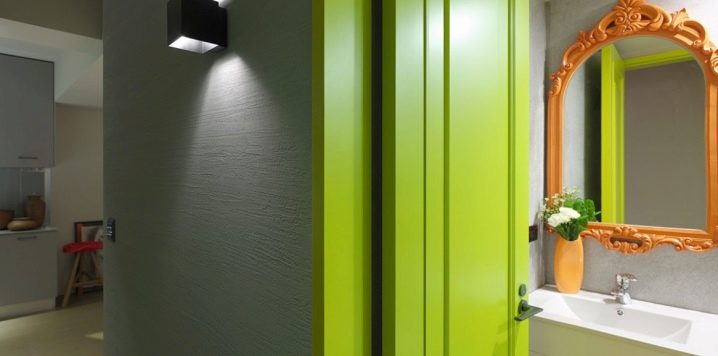
There is no unambiguous leader in the list of manufacturers, but there are manufacturing countries whose products are time-tested and are considered high-quality and reliable:
- Germany. For many, the name of this country is a symbol of reliability, durability and excellent quality, and the German concerns Hörmann and ComTür confirm this truism. In the product line of these manufacturing giants, you can find doors for every taste, but such a pleasure will not come cheap.
- Japan. This country, in addition to the impeccable properties of the products, is also characterized by refinement, originality and laconic elegance. Japanese collections are rich in unobtrusive decor, sliding mechanisms, products for small spaces. If an apartment needs a sliding module or a minimalist design lacks shojo-style doors, you should definitely look for them among Japanese manufacturers, which are still few in the Russian market.
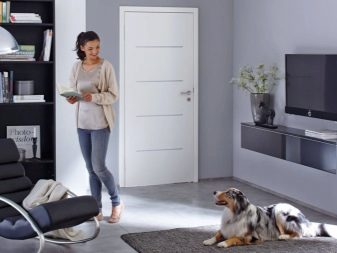
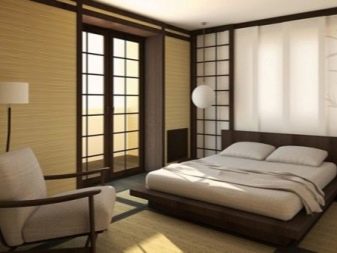
- Spain. This country is the flagship in many industries. Spanish interior doors are produced in different styles, from classic to modern, and 100% meet expectations, whether it is a steel monolith to protect valuable things in the house or lightweight doors for the bedroom. The products of the Luvipol and Fineza Puerta factories are especially popular in Russia.
- Russia. Domestic-made apartment interior doors are in no way inferior to European ones. Often, with a similar quality, these are also budget options, since raw materials for the manufacture of materials are not exported from other countries and are cheaper for the manufacturer. Among the large number of finished products, there are options for the "cheap and cheerful" category, and products of the middle price category, and premium elite doors. It is worth paying attention to the companies "Volkhovets", "Art Deco", "Sophia", "Matador", and the recently expanded production of the plant "Guardian".
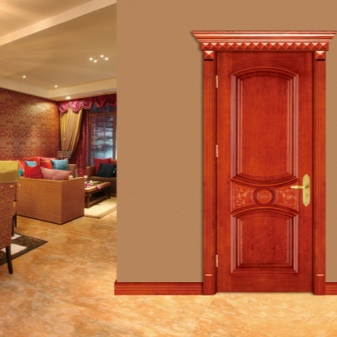
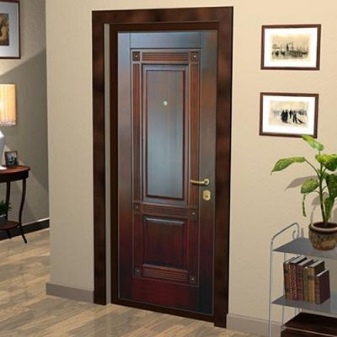
Design ideas and novelties
Contemporary designers offer novelties in the following categories.
Style
Decorating a room in a specific style is a great solution to liven up the interior. As the dominant trend, you can choose the historical style, ethnic or modern.
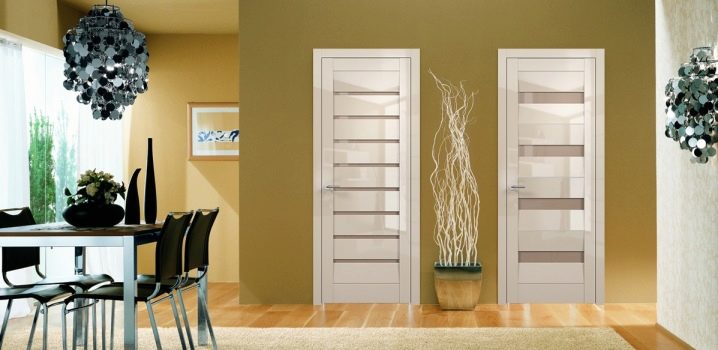
Historical style interesting is the avant-garde with its tendency to bright contrasts. It welcomes extraordinary combinations and bold colors. For this purpose, wooden, plastic and glass doors of different colors and designs are suitable.
It is also worth paying attention to the solid and restrainedly beautiful Victorian style, extravagant modernist style, democratic eclecticism, dynamic expressionism, giving complete freedom for creativity, comfortable and functional constructivism, most suitable for Khrushchev houses and small-sized apartments, the wealth of art deco, in which the door can become the highlight of the whole composition.
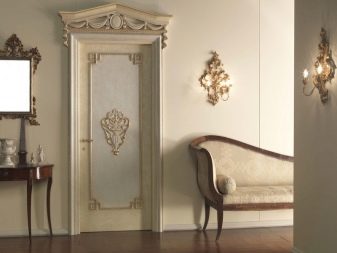
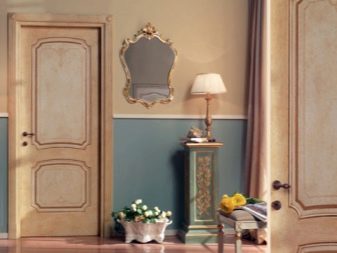
Ethnic styles help to create a unique flavor in the room. Here, experiments with the design of doors will come in handy. English, Russian, French Provence and Scandinavian styles are suitable environments for traditional wooden swing doors with different finishes. Veneer, decoupage, and transoms in different shades of precious metals will be appropriate.
Asian styles suggest light sliding and folding structures, in the eastern and Egyptian, a screen door or fabulous curtains will have to be in place instead of a blank canvas.
African, Mediterranean and Moroccan dispose to laconic rude designs made of natural materials.

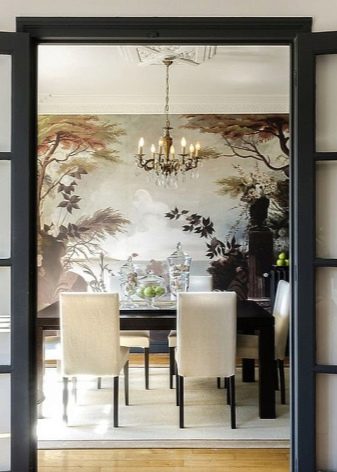
Contemporary styles - space for creativity and experimentation.
Grunge - this is a copied classic, but with cheaper and more modern materials, the cult of the availability of materials dominates in modern times, therefore the definition of “simple and tasteful” can be considered a synonym for style.
Loft - this is the realm of industrialism, space and contrasts, for example, the combination of glass doors with brickwork or concrete.
Minimalism is dominated by cream tones, simple textures and an obligatory bright accent that expresses individuality. A bright door can become such an accent.
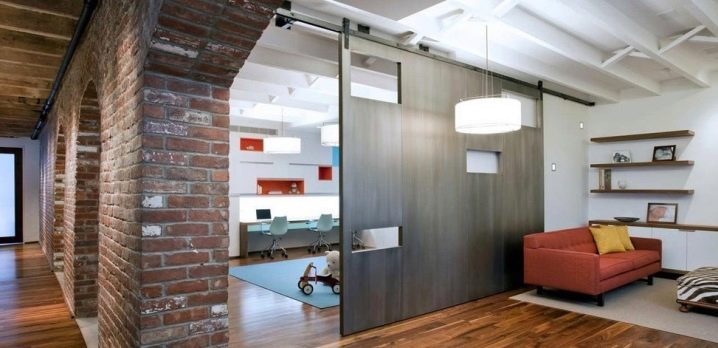
Kitsch and Pop Art - this is contrast and symbolism - the door can be made of red plastic or with the image of an idol of past years.
Techno and hi-tech - this is the dominance of the latest materials, glass and metal structures, chrome surfaces, smooth and clear lines. Acrylic door with chrome handles - accurate hitting.
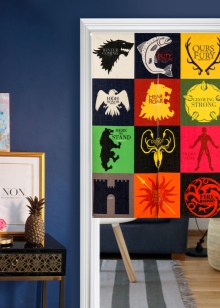
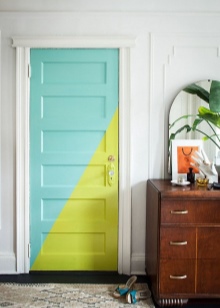
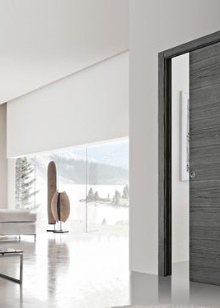
The form
Classic swing doors are increasingly replacing beautiful and non-standard designs: arched doors, semicircular transoms, folding structures, saloon doors.
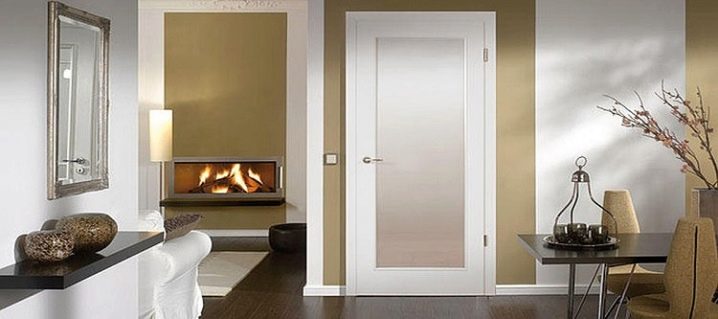
Material and texture
Novelties of interior doors practically cannot do without glass. Decor, panels, various inserts are made from it. Fully acrylic or plexiglass canvases are very popular.
Transparent glass doors are great for the living room, while frosted ones can be installed in more intimate spaces.
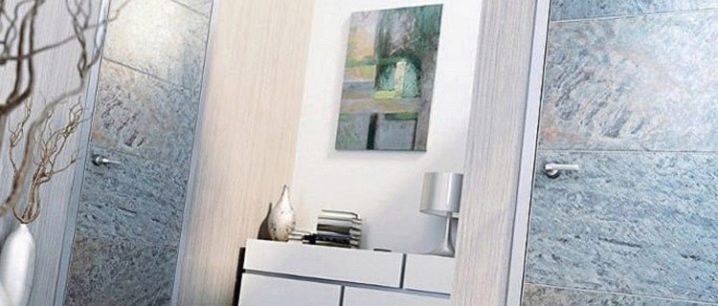
Decor
Experiments with door lighting, molding, unusual accessories (enamel and chrome handles, brass products, imitation of bronze, gold and silver), laser cutting, airbrushing, stained glass elements are welcomed.
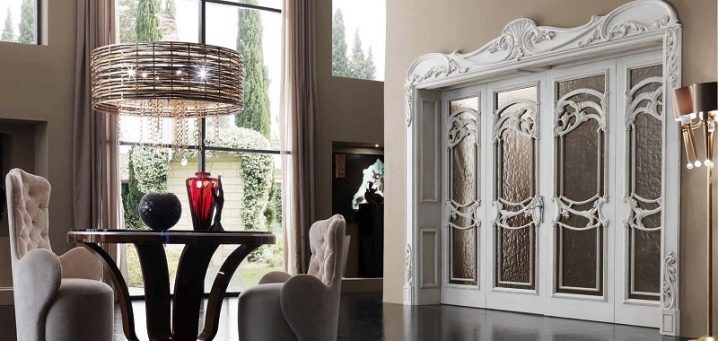
Modern options in the interior
It is not difficult to introduce market novelties of interior doors into the interior. At the same time, the statement that all rooms in an apartment should have the same doors is already outdated. Today, you can use laconic budget doors to the pantry and stylish design solutions to the bedroom.
Steel doors of Premium and Lux class with natural veneer finish are perfect for a study. It is reasonable to install canvases interesting in color and texture in the children's room, but resistant to damage. Creative and fashionable plexiglass sliding doors will help to transform the kitchen.

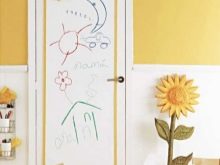
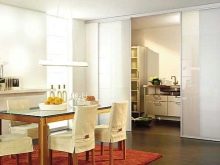
Elegant rebated doors are also available for non-standard sizes of rooms and doorways. For a private house, custom-made doors are relevant in individual sizes from different materials and with variable opening mechanisms, from swing to telescopic.
And in a compact Khrushchev, it is most convenient to install cassette doors in all rooms, including a wardrobe niche in the wall.
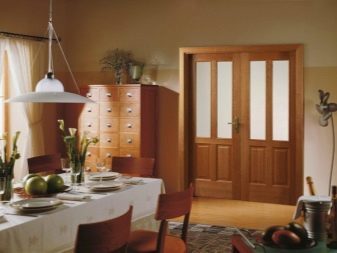
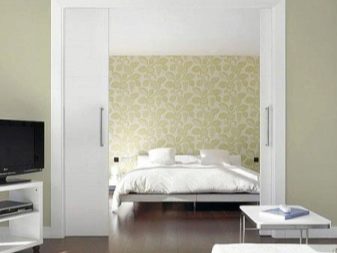
What material is the best choice for interior doors? The answer to this question awaits you in this video.













The comment was sent successfully.